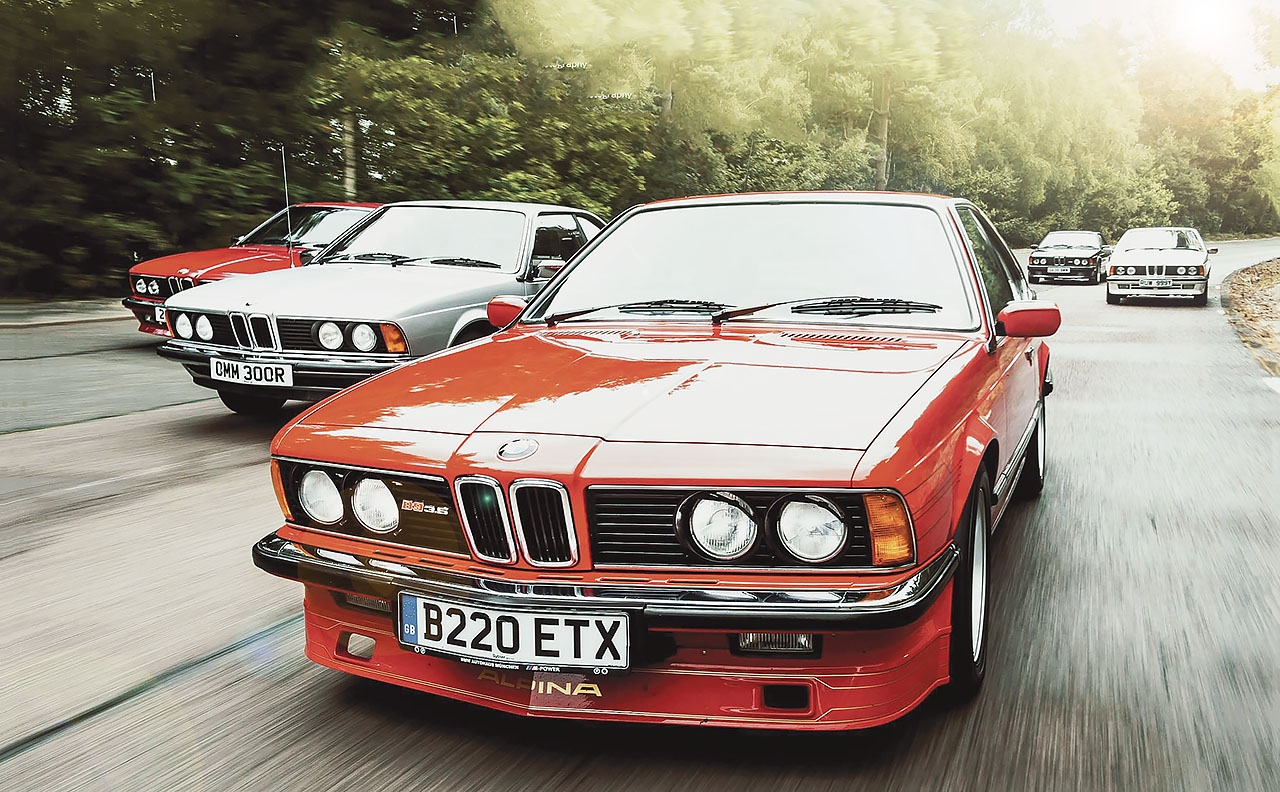
BMW 6 series at 40. From BMW 628CSi E24 to Alpina B9 E24, we pick the must-have supercoupé of 2016. We celebrate the BMW 6 Series’ 40th birthday with a high-speed blast in everything from frugal 628 to licence-losing M635 and Alpina B9. The Big Test As the E24 BMW 6 Series hits 40, we test all the key models including the 628CSi, 633CSi, 635CSi, M635CSi and Alpina B9 3.5, and interview 635 race ace Dieter Quester. These cars represent the full spectrum, from swift cruiser to twisted A-road bruiser.
The joy of six
BMW 6 Series Coupe blitzed the autobahns and the motorways. Forty years on we feel the speed in everything from 628CSi E24 to an Alpina B9 E24.
Five sets of twin headlights are fixing me with a purposeful scowl from across the car park. Spanning 628CSi to M635CSi they represent the full spectrum of BMW 6 Series virtues, from finely balanced swift cruiser to twisted A-road bruiser. This 40-year-old design represents a sort of coiled self-confidence that defines BMWs to this day, and they form a period of the make’s steepest climb from obtuse choice to company car park ubiquity.
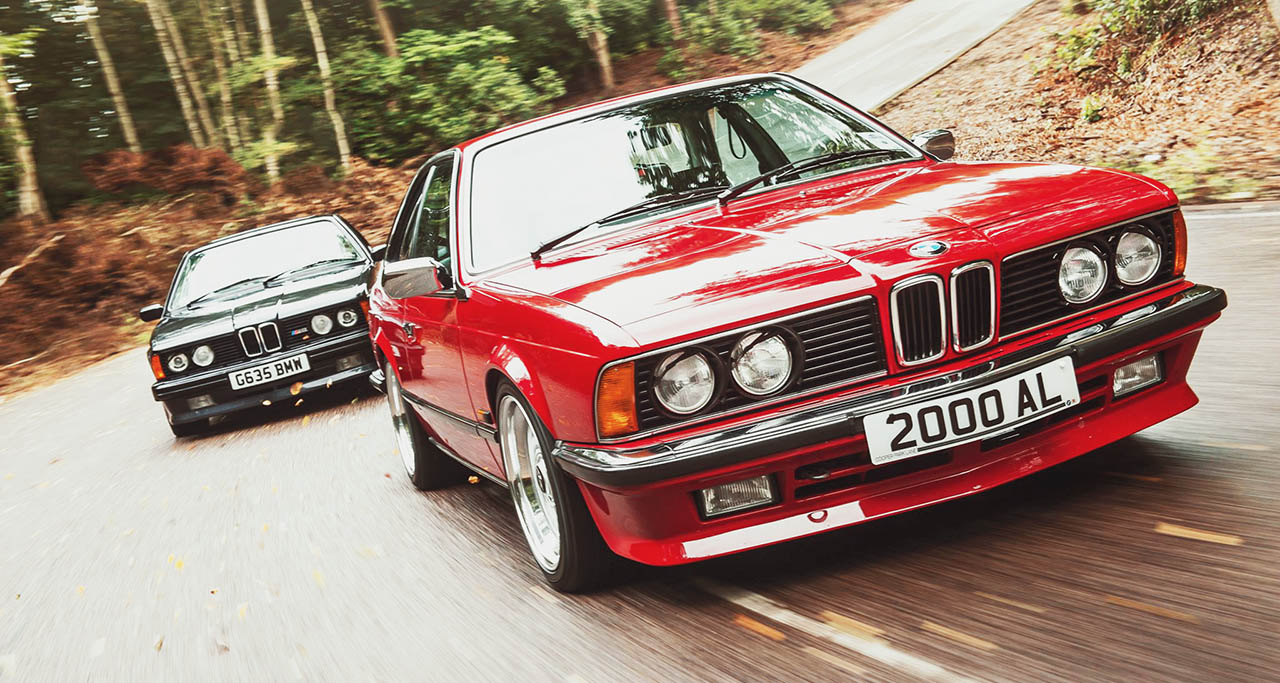
Yes, for anyone who grew up any time from the Eighties onwards it might be hard to imagine when the company from Munich was a mere minnow compared to Mercedes-Benz. In the Fifties, attempting to muscle in on the automotive behemoth’s market share – albeit with its delicious BMW 507 roadster – almost put the company out of business, so a different strategy was required.
Cue the innovative ‘Neue Klasse’ saloons in 1961, aimed firmly at the middle market. The instant success of these stylish, beautifully engineered family cars must have taken even Munich by surprise, but crucially it laid the financial foundation for model expansion. Eyeing the prestigious coupé class BMW started small with the four-cylinder 2000C and CS, but it was the subsequent six-cylinder E9 variants that upped the game significantly. By the time the new 6 Series arrived in 1976, the young pretender now stood toe-to-toe with the once undisputed king of the coupés. To celebrate four decades of the 6 Series, we’ve collected five big beasts. It’s a chance to explore just what made them so formidable.
BMW 633 CSi
‘Good luck finding a 633CSi now,’ said a member on the BMW Car Club of Great Britain’s 6 Series forum, and it’s understandable why. Few of these earliest models to hit the UK survive now, but luckily Nigel Steel has a couple and today he’s brought along the earlier one.

6 Series launched in the UK as the 633CSi (silver); base-model 628CSi came later. Fuel injection and torquey six-cylinder unit provide swift, efficient progress. Luxurious interior blends velour and leather perfectly.
Popping the driver’s door reveals an Osnabrück-based coachbuilder Karmann Karosserie plaque; as with the E9 the company retained body production and overall assembly rights before BMW brought the latter in-house in August 1977 to tighten up production standards. Underneath sits an E12 5 Series saloon platform, identical in wheelbase to the BMW E9, which allowed seamless integration of the old coupé’s drivetrain. Under the bonnet I’m greeted by the venerable M30 engine, with its familiar extra-digit clenched tubular fist induction manifold, here in 3210cc form.
Aesthetically the overall design is a little chunkier than its predecessor, accentuated by the loss of the E9s satisfying pillarless look. Designer Paul Bracq had to ensure the new coupe adhered to strict new US crash regulations, so a rollover bar was incorporated between the B-pillars. The car is longer, lower and wider; the result is definitely handsome, and with a more pronounced shark nose.
In the cabin the benefits are clear – with a seven per cent glass increase, visibility is up a notch. The finish is a measured study in Seventies Germanic elegance, and to a standard befitting the flagship model. Plastics are of a high quality and even the standard velour interior, as here, has leather bolsters. The unique loop-and catch seatbelts are a visual delight, and to the right of the steering wheel sits the innovative Active Check Control panel, with seven lights that allow the driver to check key fluid levels and systems.
A turn of the ignition and it assures me everything’s ready to go. Unlike the carburettor-fed 630CS that we didn’t see in the UK, this has Bosch L-Jetronic fuel injection and that ensures an immediate response. There’s plenty of low-down torque and with 210lb ft available it surges forward impressively under heavy load. Its three speed autobox shifts efficiently, although its final ratio of 3.25:1 – compared to the manual car’s 3.45:1 – ultimately limits top speed. The handling surprises me because for such a big car it’s quite agile. The ride is firm, but not to the detriment of low-speed work. When I push it hard it does wallow, but overall it’s confidence inspiring as long as my foot remains on the throttle. Get up to speed on a straight, though, and as a cruiser it’s immense.
As a first blow the 633CSi was impressive but better was to come. Production continued through into the second-generation E24 cars, which arrived in 1982. Although visually similar, underneath the E24/1 was re-engineered, sharing much with the new E28 5 Series model. Heavily revised suspension plus a lightened and strengthened bodyshell made the new car a significantly better performer.
OWNING A 633CSi
Nigel Steel has owned this 633 for eight years, after originally going to buy it as a spares car for his other one. ‘Bodily it was excellent – with a few small bits of rust. It needed a new gearbox because it would only go backwards, and it overheated because of a cracked cylinder head.’ He fitted another gearbox, as well as a later less crackprone cylinder head from a 1984 6 Series, and never looked back. ‘It’s a very early one. A ’76 build, registered the following year and is chassis 16 of the UK cars. On the road it’s almost agricultural compared to the later ones. It’s a smooth ride but it doesn’t have the same performance and the 3-speed gearbox limits the top end. ‘Reliability is very good and, although some trim parts are no longer available, you can get all mechanical parts from BMW – they’re not cheap, though.’ Nigel says you should budget about £300 per year to run one.
‘Reliability is very good and you can get all mechanical parts from BMW’
BMW 628CSi
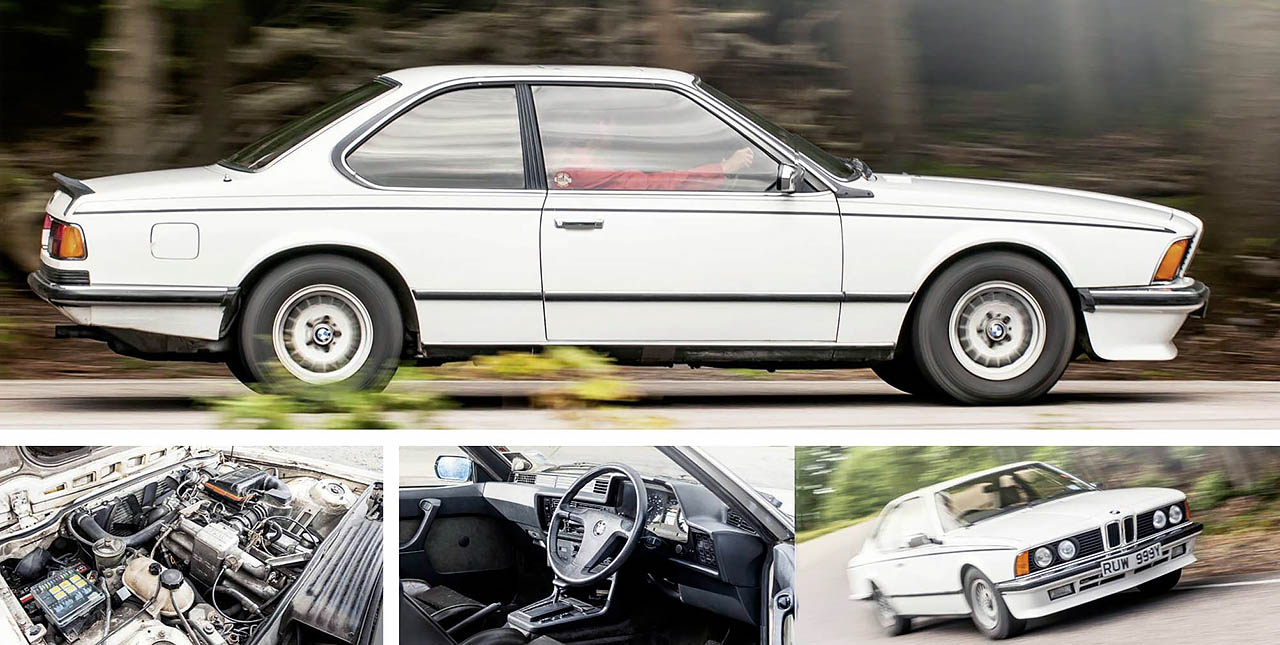
BMW 628CSi E24 normally did without spoilers, though this one may have had them specified by the first owner. 2788cc engine good for 184bhp and 0-60mph in 8.5 seconds. Interior may lack some of the toys of the 635, but it’s just as reassuringly solid. LJK Setright once said the 628 didn’t feel fast at 130mph – as a compliment.
If Nigel Steel’s 633 is a great survivor, then finding this 628CSi could be viewed as nothing short of miraculous. Less desirable variants of models invariably have a higher attrition rate, and sometimes owners feel they own the poor relation, offering sheepish looks towards the top-of-the-range models.
Not so here, because Oren Paynton loves his example and is proud to display this daily cruiser in any company. The original buyer, however, ordered it de-badged. Given that he was a doctor living in Hampstead it’s possible to surmise he wanted the combined 6 Series kudos and driving experience allied to improved fuel economy – all without the neighbours finding out, of course. Without the standard fittings of its big brothers – including front apron spoiler, ventilated rear brakes and air-conditioning – the 628CSi slotted in as the budget version of the range. Not that the 1980 UK asking price of £16,635 was much of a bargain. Power came via the 528i saloon’s 3.0-litre M30 engine, kicking out 184bhp – a single horse down on its 5 Series incarnation – and 173lb ft of torque. That made it quick, if not scintillating, and period reviewers didn’t hesitate to point it out.
Inside, it’s all 6-series – ignore the leather seats, sourced from a later 635CSi – and only the absence of a few standard toys make it feel built down to a budget. I do have my onboard computer (£516, thank you very much) and air-conditioning (£1374) but the ABS and sports suspension boxes were never ticked.
After less than a lap of the test route I can sense my passenger’s curiosity. ‘It actually more than holds its own in this company,’ I reassure. Direct comparisons with the earlier car are inevitable, but because the later chassis is more lithe and the automatic gearbox now a four-speed unit with overdrive top ratio, it feels the generation younger that it is.
The new suspension layout – with steeper-angled and now linked trailing arms – negates its predecessors’ tendency towards lift-off oversteer, increasing my confidence in driving it harder. Forward progress is deliciously smooth, with that delightful straight-six a creamy deliverer of its wares; you do have to work it, though, because below 3500rpm it’s a touch gutless. But revving it is one of life’s joys.
Compared to the high-performance variants gathered, it’s the sedate choice – even the 1977 car will out-drag it – with a significant deficit in any direct oomph-anchors comparison. That said, I’m able to sit back smugly as their fuel economy quickly disappears into the teens when their power is unleashed.
Fuel economy was always the key selling factor for this model. Therein lies the crux. Even in period, up against rivals such as the Jaguar XJ-S 3.6, Audi Quattro and Opel Monza, while performance lagged behind, the miles-per-gallon return compensated, and is the reason why at one point this model accounted for a third of UK 6 Series sales. It’s a shame so many have disappeared, either abandoned or harvested to help its more illustrious brothers survive.
OWNING A 628CSi
‘It was a bit of a chance buy,’ says Oren Paynton. ‘I bought it from the original owner, so it hadn’t been messed with. The 6 Series is one of the best-looking classics of the Eighties, and this was a lot of car for the money when I bought it more than ten years ago. ‘The 2.8-litre engine is rather more economical than the larger one, while the overall feel of the car remains the same. It’s not super-sporty but it just cruises with heaps of style, while having the power when needed. When the revs climb, it makes a most wonderful sound.’ Oren’s favourite trips are long motorway blasts. ‘A nice long drive does the CSi a lot of good; this is a car that needs open roads.’
He says it is expensive to work on, but amazingly most parts are still available new from main dealers. ‘BMW engineering means little goes wrong. Bodywork rust can be an issue, and costly to repair.
‘I carry out simple tasks myself to keep costs down but owning a complex 32-year-old car, you’re always going to have a long to-do list. I don’t budget for it but I spend on an ad-hoc basis, according to need and available funds.’
‘It’s not super-sporty but it just cruises with heaps of style, while having the power when needed’
‘I RACED ONE’ Dieter Quester
He took the ETCC title in 1977 in a 3.0CSL, and won it again six years later in a 635CSi. So how good was the E24 as a racer?
‘There was no other car to use, so the only solution was to use the coupé in the ETCC and German national championship. If you compare the 635CSi to the CSL, the 6 Series was 100 per cent a touring car but also more of a street car. The CSL – with its wings – was developed as a racing car first. On the rear of the 635 we only had a rubber lip on the trunk; no big wings or big front spoiler. It would have been a faster car with better aerodynamics, but these were the regulations.’
Although Team Schnitzer-prepared, it was essentially a factory works racer with the budget coming from BMW. ‘The car was extremely reliable, but the engine was not as powerful as the TWR Jaguars. It was at least 100bhp down on the XJ-S, but our advantage lay in its very good handling and good fuel consumption.’
Despite having the fuel-efficiency hold over the Jaguars, Quester remembers one particular race at the Nürburgring, on July 10, 1983 being closer than it should have been. ‘We were sure we could beat them on fuel consumption but were very surprised they could drive roughly the same distance as our car. Twenty years later I met TWR Jaguar Racing driver John Fitzpatrick and I asked him how they managed it. He said they had a very special fuel tank in the roll cage that gave them perhaps an extra 10 to 15 litres of fuel. Tom Walkinshaw was a very clever manager, but always on the limit – we won the race but it had been very close.’
That year’s championship would go down to the final race at Zolder, where fourth place secured the title for the BMW Schnitzer 635CSi. Despite an inferior outright victory count – two to the XJ-S’s four – the BMW’s superior reliability and greater number of second-place finishes helped claim the crown.
One of his favourite memories involved co-driver selection. ‘I wasn’t with the same driver each time. For my first race BMW put forward Carlo Rossi, but then they suggested an Austrian. They said he drove in Alfasud and Formula series, but wasn’t very famous – Gerhard Berger.
‘I said, “I don’t want to be a driving school,” and drove with Rossi. We won the race and I was very happy. Years later, Berger paid me back; it was a race in Macau and Gerhard found the right way to more or less say, “I don’t want to drive with Quester.”
One thing he laments is that the M635CSi never ventured trackside. ‘Engine-wise, it would have been the perfect car for the series. I think the power would be 150 to 200 horses more, and it would have been a much quicker car than the Jaguar.’
BMW 635 CSi
If Kos Loizou were the type to brag, he could say, ‘You can take your Alpinas, you can take the M with its cumbersome moniker and… whistle.’ For this is the real poster car for the 6 Series. Why? It’s the one with touring car kudos. It was never intended to race but privateers like Racing Corporation Vienna and Eggenberger Racing proved it could be competitive.
The switch from Group 2 to Group A – modified touring cars, based on production cars with annual sales of 5000 – coincided with the arrival of the lighter, second-generation E24s. It was clear the current 528i saloons couldn’t cut the Dijon against TWR’s V12 Jaguar XJ-S racers, so BMW homologated its new coupé.
With the company’s backing, Team Schnitzer prepared the car for the 1983 ETCC assault and, in the expert hands of Dieter Quester, secured the title in its debut works season. It would remain competitive until the 1987 arrival of the E30 M3, which was so fast that it immediately put the 6 Series out to pasture.
Kos’s car is original save for the ACT split-rim alloy wheels – replacing the original metric items and Michelin TRX tyres – and moderately lowered suspension. It’s fully loaded, with sports seats, leather interior, automatic gearbox, air-conditioning, sports steering wheel and a tilt-and-slide sunroof. You’d be excused for thinking red would be a colour to avoid on such a large car but it’s one of the E24’s best hues; the marked contrast with the black slatted front grilles lending it an extra air of menace. Inside, the black leather interior screams machismo and with more than 20 electronic seat manipulations I’m able to get myself perfectly set.
This new 635CSi – the model originally arrived for the 1978 model year – boasted a fresh engine, a new 3430cc unit that brought it back under the M30 umbrella. At 100mph on our test loop the big coupé is absolutely rock-solid; fourth gear on the autobox has the engine ticking over at a relaxing 3000rpm – you get the feeling it could sit there all day without missing a beat. A return from warp speed and a tweak of the rotary control on the automatic gearbox moves it from Economy to Sport mode; this engages the electro-hydraulic control system, setting the engine for maximum acceleration – shift points are moved higher up the rev range and top gear is locked out completely. The 0-60mph sprint takes just 7.5sec but it’s the 50-70mph time of 4.7sec that will dispatch fellow motorway users with relative ease.
The gearbox has another trick; a 3-2-1 setting with a torque lock that allows gears to be held to maximise engine braking on hairy declines or attacking steep hairpin bends – perfect if you live in an Alpine country, although a little less necessary in leafy Surrey. As a high-speed motorway mercenary it’s ideal, and yet despite relatively supple suspension it’s also a highly competent B-road blaster when necessary. That, combined with its racing pedigree, makes the 635CSi the go-to model for those lusting after a 6 Series.
‘At 100mph on our test track the big coupé is absolutely rock solid’
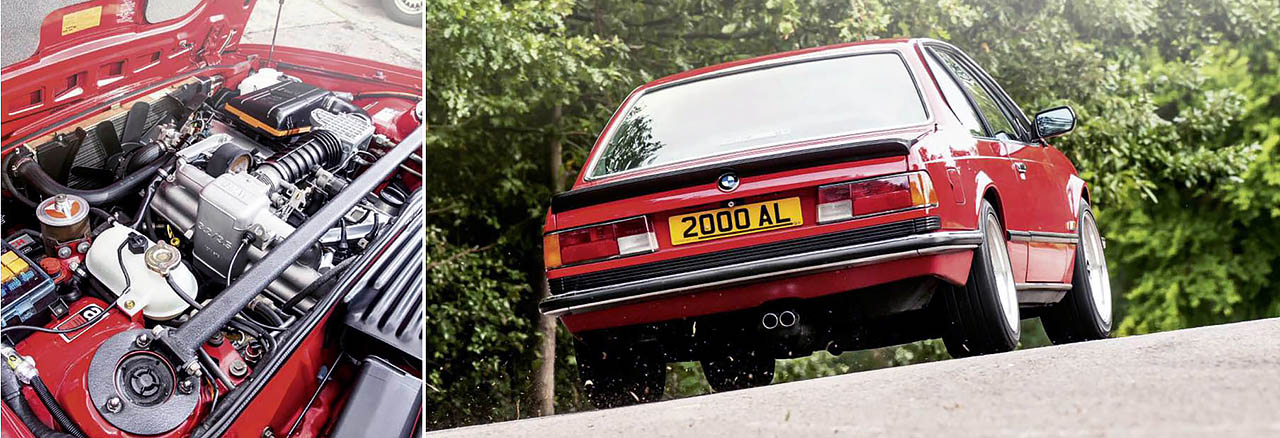
3430cc six is an über-relaxed cruiser but offers blistering acceleration with the autobox in Sport mode. 635CSi quickly built a reputation for tail-out antics in the wet.
OWNING A 635CSi
Konstantinos Loizou’s car used to be his father’s. ‘I remember going with my dad to collect it from MLG of Chiswick when he bought it at three years old, in 1989. “See that red car? That’s mine,” he said. ‘It’s been very reliable over the past 10 years since I’ve taken it on. Last year I took the head off for a top-end overhaul, and I’ve rebuilt the brakes and suspension. The only problems I’ve had were a seized master cylinder and intermittent starting issue (a fuel DME relay).’
He says aftermarket parts options are decent but you have to be careful. ‘Only ever buy known brands from the likes of GSF and ECP. There are several specialists who can assist with maintenance, diagnostics and locating spares.
‘If you buy a good 635CSi – and there aren’t many around – then routine maintenance is enough. They don’t require a specialist as such, but using someone who had experience with them is advisable. I try to use it as much as possible, even through winter, because like any classic it needs to be used.’
BMW ALPINA B9 3.5

Deeper chin spoiler hints at hardcore intent. No-nonsense Alpina four-spoke steering wheel just begs to be played with. Bilstein dampers, shorter springs and thicker anti-roll bars mean the Alpina is a B-road blitzer. Buchloe’s tweaks tickled 245bhp out of BMW’s M30B35 straight-six engine.
Alpinas either do it for you, or they don’t. I must admit I find the more common green and blue Deko side-stripe set a touch garish for my sensibilities.
However, here on Les Harris’s B9, the discreet Gold on Henna Red colour scheme works delightfully. Coupled with the more aggressive front air dam, lower stance, Alpina rear spoiler and 20-spoke alloy wheels, it makes for a striking car. Yet the products of Burkard Bovensiepen’s company have never been purely about show. It’s what lies underneath that clients paid way above and beyond the 6 Series asking price for.
Two B9s were built with the older, freer-revving 3453cc unit before it switched to the B9/1 type. The 3430cc unit was comprehensively tweaked, incorporating a 280-degree camshaft, high-dome pistons, hemispherical combustion chambers for more efficient burn, oversized intake and exhaust valves, and polished, lightened and balanced conrods. The result is 245bhp at 5700rpm and 236lb ft at 4000rpm. That’s a healthy 12.4% increase o the standard car, but not quite the lightning rod through the Trumps pack that you’d have expected for the money. But when accelerating in this example it feels a hell of a lot harder-edged than the 635CSi. That comes as a bit of a surprise, for a car that’s just under a second quicker from 0-60mph – yet it’s never to detriment of comfort, with no more cabin noise ingress than the 635CSi and only the firmer ride setting it apart. The meaty, close-ratio manual Getrag gearbox is the perfect foil for all that power, and suits the car’s high-performance disposition.
In serious twisty action where the standard car is good, the Alpina excels. Comprehensive chassis and roadholding work, including Bilstein gas dampers, shorter springs and thicker anti-roll bars, coupled with 16-inch alloy wheels shod in Pirelli P7 rubber, means I can work it notably harder. There’s a certain something about its inherent balance that directly reflects on the clever work that those engineers put in.
Those at Sytner Nottingham, that is. Despite the power unit being built in Germany, the rest of the conversion work was completed at the only other company outside Germany licensed to do so. The Midlands operation produced just 13 cars in right-hand-drive B9 specification, and only two in Henna Red.
Alpina itself built a quite bewildering array of E24-based models, with designations that ran across other BMW platforms. To list them here could cause the casual reader a system overload. In context, though, the B9 was an affordable Alpina aimed at a buyer who simply wanted a bit more go and handling capability than standard. Its production filled the space between the absolutely bonkers 330bhp B7S Turbo Coupé, and similarly nuts B7 Turbo Coupé/1 that followed.
B9 production would be relatively short-lived, with Alpina deciding to develop that second generation of turbocharged engine, because in 1983 BMW’s very own hot 6 Series offering, the 286bhp M635CSi, was unveiled, at a considerably lower asking price.
OWNING AN ALPINA B9
‘I owned a 635 and an M635 in the early Eighties; they were my dream cars so I always wanted to own one again, especially a genuine B9 Alpina E24,’ states Les Harris. ‘I bought it two years ago and was overwhelmed by how well it performed. I’ve had it serviced and MoT’d twice at BMW dealers, and it’s never needed any remedial work.
‘Although the car is over 30 years old, it’s got superb performance, fantastic brakes and roadholding that would put many new cars to shame. Despite the performance, the cabin is very quiet on the move.’
He cites the blast home from South Wales on the M4 after buying it as one of his highlights, along with the recent parade laps for Alpina’s 50th anniversary celebration at the July Silverstone Classic.
‘People often ask me if the car is for sale,’ reflects Les. ‘The answer is no. Where could I find another as good?’
‘I bought it two years ago and was just overwhelmed by how well it performed’
BMW M635CSi
What’s in a name? Well, given the performance at the disposal of an M635CSi it could well lay claim to being ‘the ultimate driving machine’. BMW’s marketing department, on the other hand, might well have been less than ultimate in its PR skills. No one could see the benefit in simply badging it as an M6 – as it was always known in the States – rather than the unwieldy M635.
The Motorsport division’s decision to fit the M1 supercar’s M88 light-alloy – ironically based on the ‘old’ 3543cc block – 24-valve engine, on the other hand showed great foresight. Because the end result is just scintillating. Kicking out 9bhp more than in its M1 incarnation – thanks to a higher 10.5:1 compression ratio, made possible by Bosch ML-Jetronic injection and Motronic digital engine management, and free-flowing exhaust system – this is a free-revving screamer.
To cope with the extra power and torque, the suspension and chassis received 15 per cent stiffer springs, Bilstein gas dampers and thicker anti-roll bars; mechanically, a beefier clutch and ZF closeratio gearbox completed the package. On the outside, though, it all remained fairly discreet with just a strategically placed M badge on the front grille and rear.
This 1989 model is one of the last cars produced, and both a Highline and Motorsport Edition to boot. The former denotes a trim level that included shock-absorbing colour-coded bumpers, and an approach to applying soft Nappa leather to the interior that borders on extreme bondage – everything’s covered, including headlining and A- and B-pillars. The Motorsport Edition was a special run of 20 cars produced by BMW GB in three colour combinations, including five in this Macao Blue exterior/Lotus White interior combo, and with Shadowline exterior trim – black, instead of chrome window surrounds – and M-Sport-tagged seats. Here’s the eye-watering bit; the 6 Series in general had increased in price throughout production but in the final few years, as the level of luxury continued to rise, it grew at an even faster rate. The original buyer of this example paid £46,995 – more expensive than a Ferrari Mondial, Lamborghini Jalpa or Mercedes-Benz 420 SEC C126 (W126-series S-Class based Coupe).
So what did he get? A car that pootles along with a light foot, and barely a hint of what lies beneath; but drop a ratio on the ZF closeratio box, nail the throttle, and it goes through a character transformation in extremis; above 3500rpm the engine lets loose a honed mechanical bellow, while the exhaust emits its hard-edged straight-six war cry. If adrenaline is your drug of choice, then there’s a ready supply – just apply right foot and you will receive.
Releasing the throttle, my brain has barely caught up with what just happened. But getting on it again, I’m able to take in the level of thrust available. For a car weighing more than 1500kg, it’s seriously quick. Thanks to four-pot racing calipers and huge discs, stopping power is strong, and its handling is the equal of the Alpina. Despite this example’s added luxury, it’s mechanically identical to the first M635CSi released back in 1983. No wonder it scared the B9 clean out of Alpina.
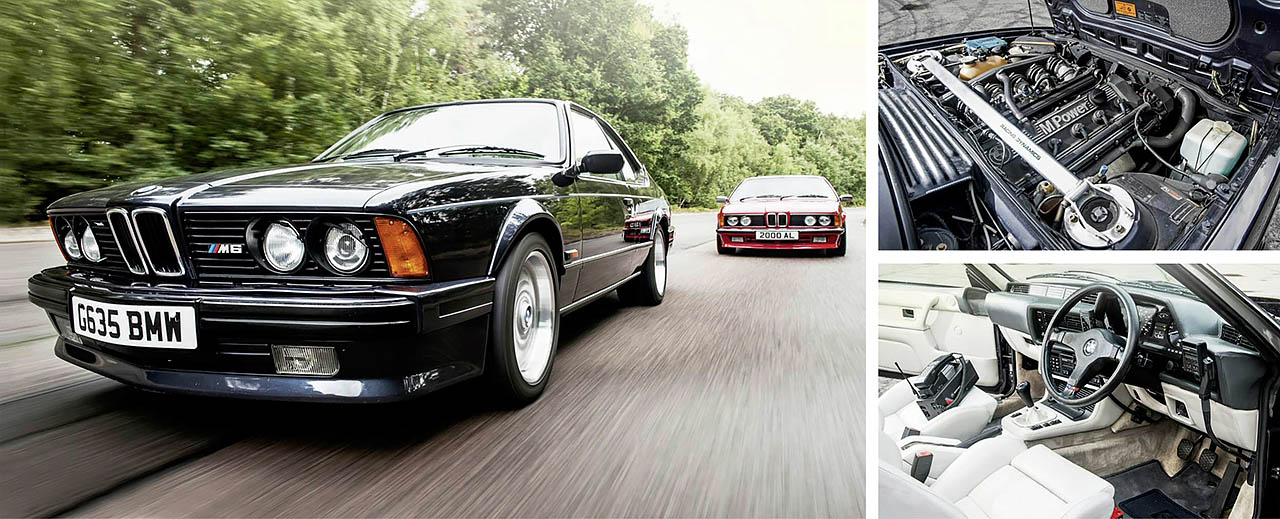
Twin-cam, fourvalve M88 engine was born for the BMW M1 E26 supercar. ‘Hello? Yeah… I’m in a M635CSi… it’s superb’. Subtle badge makes a 286bhp promise.
OWNING AN M635CSi
‘A family friend had one back in the Eighties, and I was besotted by that car,’ explains Michael Parchment. ‘I have owned M635CSis for many years since. It’s the styling, particularly the aggressive, thrusting front end. I always look over my shoulder when I walk away. ‘Genuinely good ride comfort, visibility, cabin and boot space means the whole family gets to enjoy the M6. The kids love it when daddy collects them from school in the “cool car”. It’s also the perfect age for a usable classic. It’s not so dated that it feels unusable in the modern world, and finding enthusiastic specialists and parts isn’t difficult.’
Michael budgets £400 per year on average to keep his in very good order, but acknowledges a mistreated or rusty one will soak up vast amounts of time and money to put right.
‘A cherished E24 feels robust and utterly dependable. If I needed to jump in my car now and drive a hard 700 miles, I have no doubt it’d perform faultlessly. My work once sent me on a 10-day European road-trip, blasting between major cities. I vividly recall dicing with a 911 on the Périphérique, my M6 loaded with engineering tools.’
‘If I needed to jump in my car now and drive a hard 700 miles, I have no doubt it’d perform faultlessly’
NETTING A BIG SHARK
‘You can still pick up a 6 Series for reasonable money,’ says Four Star Classics’ Jim Gillett. ‘Parts availability through BMW is still very good, and enough time has gone by that they have real presence on the road.’
Engines are incredibly strong and long-lived, if looked after. ‘Source a well-maintained car,’ advises Gillett. ‘With complete service history – it doesn’t have to be full BMW main dealer, as there are plenty of specialists out there. If a car has passed the 100,000 miles mark check the timing chain has been changed.’
The only other significant factor is rust. ‘Most cars will have replacement front wings.’ Boots are also prone to water ingress and if left unchecked it can enter the passenger compartment.
‘M635CSis are the most desirable. You can pick them up from £18k and we’ve sold them for £30k. The lower the mileage, the more collectable. Alpina B9s start at around £23k. Most cars we sell are 635CSis; expect to pay from £10k to £15k. The 633CSi isn’t as loved but you could pick a decent runner up for £3k, and I’ve never seen a 628CSi; they have the rarity factor, so for the right person that will be worth something.’
‘All variants offer an incredible amount of car for the money’
Which would you choose? Let us know.
{CONTENTPOLL [“id”: 56]}
THE LOWDOWN
By the time the last of 82,216 6 Series was built in 1989, the model had propelled BMW to the upper branches of the coupé tree. All variants offer an incredible amount of car for the money. If I were buying to use purely as a GT – perhaps to complement a sports car in my garage – then it would be the ultimate autobahn devourer, the 635CSi.
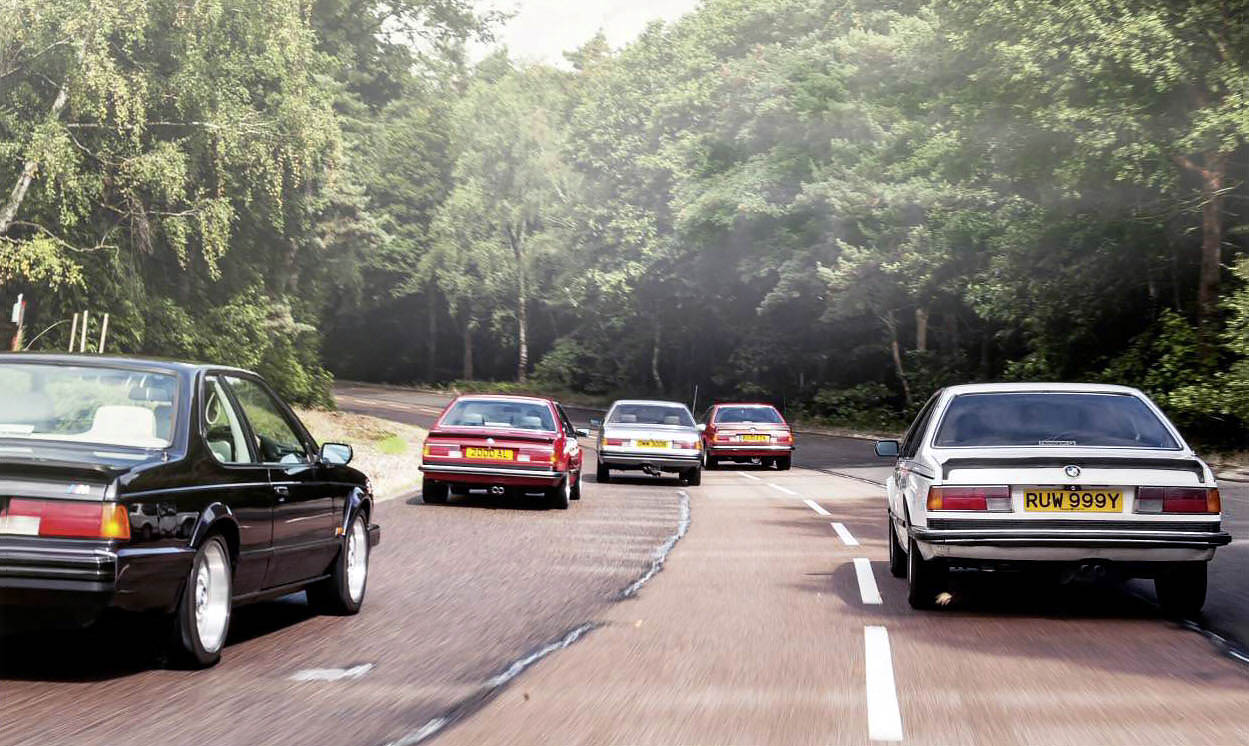
As an only car, it’s between the higher-octane M635CSi and Alpina B9, with the M taking the honours by a shark nose thanks to that glorious engine. Take rarity into account and the early E12-based cars and smaller-engined 628CSi make strong cases. One thing’s for sure – choose a top example of any of our gathered cars and pretty soon you’ll be experiencing the joy of Six.
Thanks to: The owners, BMW UK, Four Star Classics (4starclassics.com), The BMW Car Club (bmwcarclubgb.uk), Richard Head and Drive-My 6-Series E24 Club
|
Model |
1977 633CSi |
1983 628CSi |
1984 Alpina B9 3.5 |
1986 635CSi | 1989 M635CSi |
| Engine | M30B32 3210cc, 6-cylinder in-line, ohc, Bosch L Jetronic fuel injection | M30B28 2788cc, 6-cylinder in-line, ohc, Bosch L Jetronic fuel injection | 3430cc, 6-cylinder in-line, ohc, Bosch Motronic fuel injection |
3430cc, 6-cylinder in-line, ohc, Bosch Motronic fuel injection |
3453cc, 6-cylinder in-line, 24v, dohc, Bosch Motronic fuel injection |
| Power | 200bhp @ 5500rpm | 184bhp @ 5800rpm | 245bhp @ 5700rpm | 218bhp @ 5200rpm | 286bhp @ 6500rpm |
| Torque | 210lb ft @ 4250rpm | 174lb ft @ 4200rpm | 236lb ft @ 4500rpm | 224lb ft @ 4000rpm | 251lb ft @ 4500rpm |
| Transmission | 3-speed auto, RWD | 4-speed auto, RWD | 5-speed manual, RWD | 4-speed auto, RWD | 5-speed manual, RWD |
| Steering | ZF recirculating ball | ZF recirculating ball | ZF recirculating ball | ZF recirculating ball | ZF recirculating ball |
| Suspension |
Front: independent, coil springs, MacPherson struts, lower wishbones, anti-roll bar. Rear: independent, semi-trailing arms, coil springs, telescopic dampers, anti-roll bar |
Front: independent, coil springs, MacPherson struts, Bilstein damper inserts, anti-roll bar. Rear: independent, semi-trailing arms with auxiliary linkage, coil springs, Bilstein dampers, anti-roll bar |
|||
| Brakes | Discs front and rear | As 633 | Discs front and rear, ABS | Discs front and rear, ABS | Discs front and rear, ABS |
| Weight | 3280lb (1490kg) | 3170lb (1438kg) | 3186lb (1445kg) | 3447lb (1565kg) | 3329lb (1510kg) |
| Performance |
0-60mph: 8.1sec Top speed: 131mph |
0-60mph: 8.5sec Top speed: 130mph |
0-60mph: 6.7sec Top speed: 149mph |
0-60mph: 7.5sec Top speed: 135mph |
0-60mph: 6sec Top speed: 158mph |
| Fuel cons. | 20.6mpg | 25mpg | 18mpg | 20mpg | 17mpg |
| Cost new | £13,980 | £18,710 | £n/a | £26,195 | £45,780 |
| Price range | £3000-£8000 | £2750-£8000 | £15,000-£30,000 | £4500-£15,000 | £12,000-£25,000 |
| Guide | Buying Guide BMW 635CSi E24 | ||||





